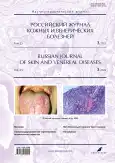Efficacy and safety of PUVA and UVB-311 nm in psoriasis: single-center retrospective study
- Authors: Yazkova O.S.1, Anpilogova E.M.2
-
Affiliations:
- Central polyclinic
- I.M. Sechenov First Moscow State Medical University
- Issue: Vol 25, No 3 (2022)
- Pages: 211-218
- Section: DERMATOLOGY
- URL: https://journals.rcsi.science/1560-9588/article/view/109903
- DOI: https://doi.org/10.17816/dv109903
- ID: 109903
Cite item
Abstract
BACKGROUND: Psoriasis is a widespread, genetically determined immune–mediated dermatosis of a multifactorial nature, characterized by a recurrent course with frequent associative damage to other organs and systems, which significantly reduces the quality of patients’ lives. For many years, phototherapy (PUVA and UVB-311 nm) has had one of the leading places in the treatment of moderate and severe psoriasis according to the world dermatological communities. However, with the advent of genetically engineered biological drugs, the frequency of its administration has significantly decreased.
AIM: to evaluate the efficacy and safety of PUVA and UVB-311 nm in the treatment of moderate and severe psoriasis.
MATERIALS AND METHODS: A retrospective study was conducted on the basis of the Federal State Institution “Central polyclinic” with the participation of 920 patients with moderate and severe psoriasis who received phototherapy (PUVA and UVB-311 nm) in the period from 2005 to 2021. The initial radiation dose was 0.5–1 J/cm2 at PUVA and 0.1–0.2 J/cm2 at UVB-311 nm with a gradual increase in the dose every 1–2 sessions by 0.5 J/cm2 and 0.1 J/cm2, respectively. The treatment was carried out according to the method of four-time irradiation per week using the UV-7001K cabin (Waldmann, Germany).
RESULTS: Among 920 patients there were 478 (52%) men and 442 (48%) women (aged 21 to 68 years). The average age of psoriasis onset is 34±5.2 years. The duration of the disease averaged 10.5±8.2 years. Vulgar psoriasis was observed in 756 (82%) patients, teardrop-shaped ― in 36 (4%), exudative ― in 73 (8%), inverse ― in 55 (6%). 249 (27%) were diagnosed with psoriatic arthritis. On average, the first phototherapy sessions were prescribed 2.1±1.6 years after the onset of the disease. The choice of phototherapy method depended on the severity of the process. Thus, with moderate psoriasis, patients were prescribed UVB-311 nm (n=473). The course consisted of 25–35 sessions of radiation with a cumulative dose of 35.3±5.9 J/cm2. Clinical remission was observed in 93% of patients, significant improvement ― in 7%. The achieved clinical remission was maintained for 361±194 days. In total, during the studied period, 149 people received 27 courses of UVB-therapy, 132 ― 24 courses, 53 ― 19 courses, 69 ― 15 courses, 58 ― 11 courses, 12 ― 7 courses. Multiple infiltrated plaques and refractory course of severe psoriasis was an indication for PUVA therapy (n=447). The course consisted of 20–30 irradiation sessions with a cumulative dose of 81.5±14.3 J/cm2. Clinical remission was observed in 98% of patients, a significant improvement in 2%. 14 people received 23 courses, 21 ― 20 courses, 12 ― 19 courses, 227 ― 15 courses, 104 ― 13 courses, 33 ― 10 courses, 27 ― 4 courses, 9 ― 2 courses of PUVA. The achieved clinical remission was maintained for 420±275 days. 12 (1.3%) patients cancelled PUVA prematurely due to the inability to take a photosensitizer. In other cases, the observed side effects were minor and did not cause discontinuation of therapy.
CONCLUSION: PUVA and UVB-311 nm have demonstrated high efficacy and safety in the treatment of moderate and severe psoriasis. At the same time, it is necessary to conduct further research to improve the methods of phototherapy for faster achievement of long-lasting clinical remission, which will allow phototherapy to regain its leading position in the treatment of psoriasis, increasing the doctors’ trust and patients’ compliance.
Keywords
Full Text
##article.viewOnOriginalSite##About the authors
Olga S. Yazkova
Central polyclinic
Email: olesha230808@mail.ru
ORCID iD: 0000-0002-9644-4778
MD, Cand. Sci. (Med.)
Russian Federation, MoscowEkaterina M. Anpilogova
I.M. Sechenov First Moscow State Medical University
Author for correspondence.
Email: truelass@hotmail.com
ORCID iD: 0000-0001-9478-5838
SPIN-code: 8499-0506
Russian Federation, Moscow
References
- Michalek IM, Loring B, John SM. A systematic review of world wide epidemiology of psoriasis. J Eur Acad Dermatol Venereol. 2017;31(2):205–212. doi: 10.1111/jdv.13854
- Elmets CA, Leonardi CL, Davis DM, et al. Joint AAD-NPF guidelines of care for the management and treatment of psoriasis with awareness and attention to comorbidities. J Am Acad Dermatol. 2019;80(4):1073–1113. doi: 10.1016/j.jaad.2018.11.058
- Psoriasis. Federal recommendations of the Russian Society of Dermatovenerologists and Cosmetologists. Revision 2022. Available from: https://www.cnikvi.ru/docs/clinic_recs/klinicheskierekomendatsii-2019-2020/. Accessed: 15.05.2022.
- Li Y, Cao Z, Guo J, et al. Assessment of efficacy and safety of UV-based therapy for psoriasis: a network meta-analysis of randomized controlled trials. Ann Med. 2022;54(1):159–169. doi: 10.1080/07853890.2021.2022187
- Lim HW, Silpa-Archa N, Amadi U, et al. Phototherapy in dermatology: a call for action. J Am Acad Dermatol. 2015;72(6):1078–1080. doi: 10.1016/j.jaad.2015.03.017
- Salvador JM, Perez-Ferriols A, Alegre de Miquel V, et al. Incidence of non-melanoma skin cancer in patients treated with psoralen and ultraviolet A therapy. Med Clin (Barc). 2019;152(12):488–492. doi: 10.1016/j.medcli.2018.09.018
- Maiorono A, Simone C, Perino F. Melanoma and non-melanoma skin cancer in psoriatic patients treated with high-dose phototherapy. J Dermatological Treatment. 2016;27(5):443–447. doi: 10.3109/09546634.2015.1133882
- Archier E, Devaux S, Castela E, et al. Carcinogenic risks of psoralen UV-A therapy and narrowband UV-B therapy in chronic plaque psoriasis: a systematic literature review. J Eur Acad Dermatol Venereol. 2012;26(Suppl 3):22–31. doi: 10.1111/j.1468-3083.2012.04520.x
- Mehta D, Lim HW. Ultraviolet B phototherapy for psoriasis: review of practical guidelines. Am J Clin Dermatol. 2016;17(2): 125–133. doi: 10.1007/s40257-016-0176-6
- Smirnov KV. Long-term results of PUVA-therapy in psoriasis [dissertation abstract]. Moscow; 2008. 36 р.
- Olisova OYu, Vladimirova EV, Babushkin AM. The skin and the sun. Russian Journal of Skin and Venereal Diseases. 2012;15(6):57–62.
- Smirnova LM, Vertieva EY, Olisova OY, Anpilogova EM. Outcomes of various types of therapy in patients with treatment-resistant acrodermatitis continua of Hallopeau. Biologics. 2019;13:83–87. doi: 10.2147/BTT.S199100
Supplementary files







